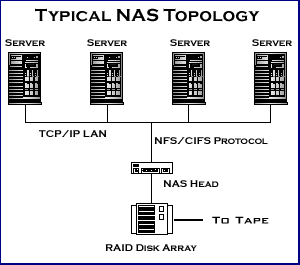
Introduction to NAS - Network Attached Storage
Dedicated network devices provide affordable, easy access to data
Several new methods of utilizing computer networks for data storage have emerged in recent years. One popular approach, Network Attached Storage (NAS), allows homes and businesses to store and retrieve large amounts of data more affordably than ever before.
Background
Historically, floppy drives have been widely used to share data files, but today the storage needs of the average person far exceed the capacity of floppies. Businesses now maintain an increasingly large number of electronic documents and presentation sets including video clips. Home computer users, with the advent of MP3 music files and JPEG images scanned from photographs, likewise require greater and more convenient storage.
Central file servers use basic client/server networking technologies to solve these data storage problems. In its simplest form, a file server consists of PC or workstation hardware running a network operating system (NOS) that supports controlled file sharing (such as Novell NetWare, UNIX® or Microsoft Windows). Hard drives installed in the server provide gigabytes of space per disk, and tape drives attached to these servers can extend this capacity even further.
File servers boast a long track record of success, but many homes, workgroups and small businesses cannot justify dedicating a fully general-purpose computer to relatively simple data storage tasks. Enter NAS.
What Is NAS?
NAS challenges the traditional file server approach by creating systems designed specifically for data storage. Instead of starting with a general-purpose computer and configuring or removing features from that base, NAS designs begin with the bare-bones components necessary to support file transfers and add features "from the bottom up."
Like traditional file servers, NAS follows a client/server design. A single hardware device, often called the NAS box or NAS head, acts as the interface between the NAS and network clients. These NAS devices require no monitor, keyboard or mouse. They generally run an embedded operating system rather than a full-featured NOS. One or more disk (and possibly tape) drives can be attached to many NAS systems to increase total capacity. Clients always connect to the NAS head, however, rather than to the individual storage devices.
Clients generally access a NAS over an Ethernet connection. The NAS appears on the network as a single "node" that is the IP address of the head device.
A NAS can store any data that appears in the form of files, such as email boxes, Web content, remote system backups, and so on. Overall, the uses of a NAS parallel those of traditional file servers.
NAS systems strive for reliable operation and easy administration. They often include built-in features such as disk space quotas, secure authentication, or the automatic sending of email alerts should an error be detected.
NAS Protocols
Communication with a NAS head occurs over TCP/IP. More specifically, clients utilize any of several higher-level protocols (application or layer seven protocols in the OSI model) built on top of TCP/IP.
The two application protocols most commonly associated with NAS are Sun Network File System (NFS) and Common Internet File System (CIFS). Both NFS and CIFS operate in client/server fashion. Both predate the modern NAS by many years; original work on these protocols took place in the 1980s.
NFS was developed originally for sharing files between UNIX systems across a LAN. Support for NFS soon expanded to include non-UNIX systems; however, most NFS clients today are computers running some flavor of the UNIX operating system.
The CIFS was formerly known as Server Message Block (SMB). SMB was developed by IBM and Microsoft to support file sharing in DOS. As the protocol became widely used in Windows, the name changed to CIFS. This same protocol appears today in UNIX systems as part of the Samba package.
Many NAS systems also support Hypertext Transfer Protocol (HTTP). Clients can often download files in their Web browser from a NAS that supports HTTP. NAS systems also commonly employ HTTP as an access protocol for Web-based administrative user interfaces.
No comments:
Post a Comment